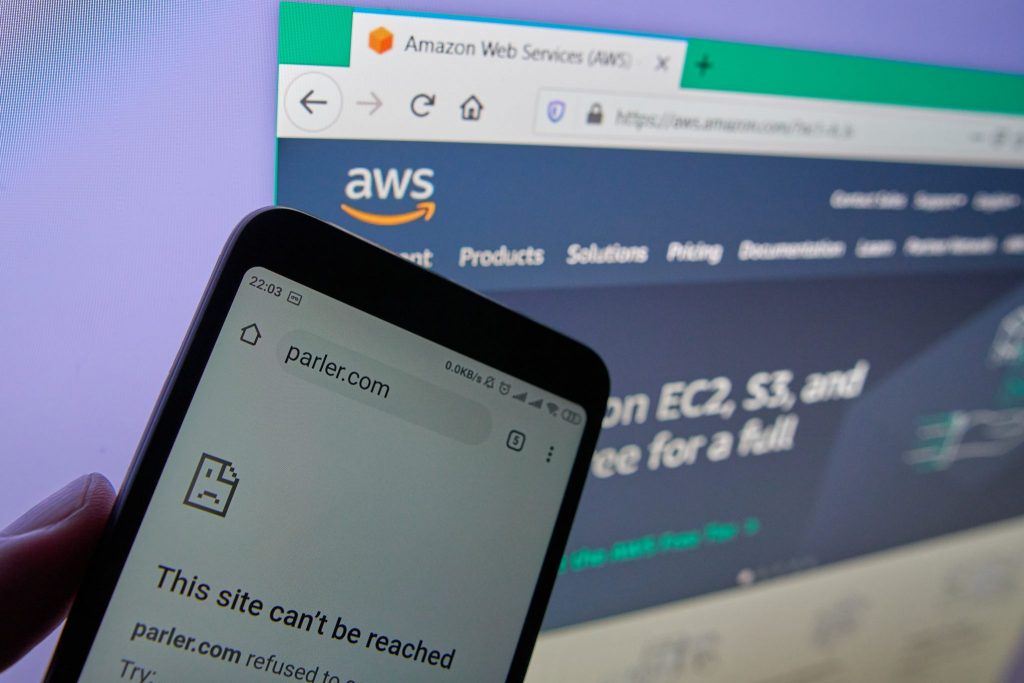
By Louie Hollmeyer, ATC
Cloud services are all the rage in the IT community for many reasons. Scalability and enterprise compute at mid-market prices are a couple that jump right out. In addition, most businesses prefer to “stick to their knitting” rather than invest heavily in an on-premise data center that requires expertise and constant upkeep, care and energy. Personally, I am a cloud advocate, but only when it makes sense. It’s not always the right fit. Usually, it’s not one or the other, but hybrid or multi-cloud.
As I watched the national news this past weekend, I caught an interview of Parler’s CEO, John Matze. I had been paying casual attention to Twitter’s ban on Trump and the removal of the Parler app from the iPhone app store and Google Play. I also heard mention of Amazon, but not until I listened to Matze did I realize the mention of Amazon—in this context—was Amazon Web Services (AWS). In my world, I frame the two separately. I personally shop on Amazon and AWS is a hyperscaler in my professional space.
Parler is reliant on cloud computing power provided by AWS.
As I watched Matze speak, the CEO of a flourishing business, I completely stopped in my tracks. On a moment’s notice, 24 hours to be exact, AWS was going to completely decommission Matze’s business. Holy smokes! Keep in mind, this is not a political piece and I do not have a Parler account, nor am I passing judgment on AWS or Parler, or the justification (pro or con) of this action.
I have to believe many other CEOs stopped in their tracks like I did. Especially, those that have moved to the cloud or have IT departments considering a migration to the cloud. The fact that Matze’s cloud partner, AWS, could unilaterally bring down his business with the push of a button is alarming. Whether AWS’s actions are deemed justified or not, the only option Matze has is to litigate against them now. Good luck with that!
Lessons Learned
It’s not unreasonable or far-fetched for a CEO to think, “Wow, could this happen to me?” At the end of the day, most CEOs and entrepreneurs want control over their own destiny. They believe in themselves. Before the interview with Matze concluded, my mind immediately jumped to the possibility that this event could trigger a reactionary diversion away from the cloud back to premise-based data centers, where CEOs feel more in control. This, I believe, would be a gross over reaction, but there are still some lessons to be learned.
Fortunately, according to Matze, Parler took precaution “for events like this, by never relying on Amazon’s proprietary infrastructure and building bare metal products.” However, given the fact that it is going to take a minimum of one week before Parler is back and up and running, if ever, I have to believe that there was no cloud diversity or redundancy built into Parler’s cloud services. It’s also safe to assume that their Recovery Time Objective (RTO) was much quicker than that. Enterprises, in particular, should not be comfortable with the concept of being dependent on a single cloud provider.
Usually, we prepare for natural disasters, cyber threats and outages. Nowadays, we include pandemics and even bombings like the one recently in Nashville where an AT&T facility was taken out. A scenario like that of Parler’s is not a scenario that typically comes to mind. Regardless, we have to prepare in much the same way.
App-by-App Analysis
 Cloud services require an application-by-application analysis to determine where certain workloads best fit. Some are better housed in the private cloud, some the public, and some are just dandy on premise. Once your cloud environment is settled, make sure you have a disaster recovery plan in place that includes exactly how much redundancy and diversity should be built in considering your acceptable recovery time. Business continuity considerations such as these are difficult because they essentially amount to an insurance policy that you hope to never cash in, which brings me to my next point.
Cloud services require an application-by-application analysis to determine where certain workloads best fit. Some are better housed in the private cloud, some the public, and some are just dandy on premise. Once your cloud environment is settled, make sure you have a disaster recovery plan in place that includes exactly how much redundancy and diversity should be built in considering your acceptable recovery time. Business continuity considerations such as these are difficult because they essentially amount to an insurance policy that you hope to never cash in, which brings me to my next point.
If you have established cloud diversity, and have your environment geographically replicated with an alternative cloud provider, consider a “business interruption” clause within your insurance policy that will cover the escalated costs accrued in the event you have to divert to the alternative cloud provider. One cloud provider of ours told me that if Parler had cloud diversity built in with his firm, Parler could have been up and running within an hour and that the costs to pull that off would have been covered by their “business interruption” clause.
Cloud providers expect clients to comply with certain standards. For example, porn is not acceptable. On the flip side, Business Associate Agreements (BAA) that hold the cloud provider accountable to certain standards is a judicious means to have “mutual” agreements. BAAs are usually synonymous with HIPPA compliance, but can be crafted specifically to the interests and standards of the client.
Style Match
Lastly, one of the more instrumental words above is “partner.” In theory, Parler and AWS were business partners. Afterall, Parler was spending $300,000 a month with AWS, according to reports. Within our firm, we call it a “style match.” When I am wearing my business-development hat, I am seeking prospective clients that are a “style match.” As an independent, digital transformation IT consulting firm, we look for organizations that view IT not purely as a cost center, but as a strategic differentiator. While we save our clients’ money all the time, the “style match” constitutes the most value for the client.
When clients come onboard and we are seeking technology services and providers that meet their needs, we are also looking for a “style match” on their behalf. While the hyperscalers like AWS, Google Cloud, and Microsoft Azure might be a good fit for certain applications, there are many viable private cloud service providers that may be a better fit for certain applications and be a better “style match.”
Remember, this is not a political piece and “style match,” as we use it above, has nothing to do with politics. A good partner is a “style match” because they are like-minded about business and technology. They are also better positioned to give you tailored solutions that best fit your needs and provide more personalized support. They are not on the dartboard. They are a bullseye. They meet your needs exactly on your level. You are not reaching up or reaching down.








